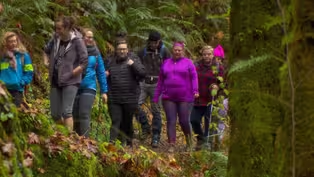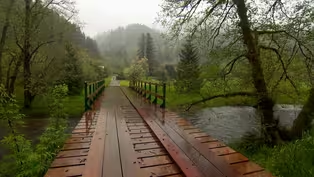Oregon Field Guide
Freshwater Mussels in the Willamette River
Clip: Season 29 Episode 11 | 9m 5sVideo has Closed Captions
What native freshwater mussels tell us about the health of the Willamette River.
Native freshwater mussels are environmental superheroes that filter rivers across North America, but their future is threatened. Members of Columbia Riverkeeper have been studying a large population of “old growth” western pearlshell mussels in a stretch of the Willamette. What does the aging population tell us about the health of the river — and the future of its mussel?
Problems playing video? | Closed Captioning Feedback
Problems playing video? | Closed Captioning Feedback
Oregon Field Guide is a local public television program presented by OPB
Oregon Field Guide
Freshwater Mussels in the Willamette River
Clip: Season 29 Episode 11 | 9m 5sVideo has Closed Captions
Native freshwater mussels are environmental superheroes that filter rivers across North America, but their future is threatened. Members of Columbia Riverkeeper have been studying a large population of “old growth” western pearlshell mussels in a stretch of the Willamette. What does the aging population tell us about the health of the river — and the future of its mussel?
Problems playing video? | Closed Captioning Feedback
How to Watch Oregon Field Guide
Oregon Field Guide is available to stream on pbs.org and the free PBS App, available on iPhone, Apple TV, Android TV, Android smartphones, Amazon Fire TV, Amazon Fire Tablet, Roku, Samsung Smart TV, and Vizio.
Providing Support for PBS.org
Learn Moreabout PBS online sponsorship- [Narrator] At the bottom of the Willamette River lives an animal about the size of a small fist.
It's a western pearlshell mussel, and it lives in beds raked by swift current, which makes studying them tricky.
- You guys stand right here and I can hold your legs.
- Right.
I'm losing it, stay on it.
- Okay.
- There you go.
- Against the current, walking around and trying to stand in place, even in this, (people laughing) it's working muscles that you didn't know you had, yeah.
- [Narrator] No pun intended, of course.
(people laughing) - [Team Member] Here, you can hold onto my ankle.
- You wanna push off?
- Sorry.
- [Narrator] Travis Williams is with Willamette Riverkeeper.
His group is studying pearlshells because when it comes to river conservation, fish get all the attention while mussels are an overlooked workhorse.
- Here's this whole universe of these really interesting animals that, in the case of the western pearlshell, can live to be over 100 years old in the right habitat.
- [Narrator] That makes them one of the longest lived animals on earth.
- [Travis] And to me, that was something that I just found astonishing.
- [Narrator] Western pearlshells are native to rivers from Alaska to California.
They're food for wildlife like river otters (bird cawing) and even sturgeon.
And while they look like they're just sitting there at the river bottom, they actually have a foot they can use to move around.
It's so powerful that they've been known to climb waterfalls.
And Celeste Searles Mazzacano says they're cleanup factories because they filter pollution as they feed.
- So they're little superpowers in freshwater ecosystems, but nobody gives them the love and the appreciation that they deserve.
Sometimes people like to say, "Oh, they're like living rocks."
And it's true that even people who work in rivers, they can be utterly unaware that there are freshwater mussels there.
(birds chirping) - [Narrator] The Willamette River should be an ideal home for pearlshell mussels, but across the west, they're in decline.
Scientists consider them threatened even though they haven't landed on the endangered species list yet.
That's what makes this research site so interesting.
Between Eugene and Corvallis, Norwood Island protects a mile-long back channel, bisected by the Long Tom River.
It's home to one of the largest known populations of mussels in the Willamette.
- Three live, one dead.
- 11.4 even.
- [Narrator] The work to count how many are here and how old and healthy they are goes like this.
Drop a square called a quadrat to the river bottom.
- [Team Member] You guys do it, okay?
- [Narrator] Count every mussel within the square.
- [Team Member] Looks like we have a dead one.
- [Team Member] Three, four.
- 11-point- - [Narrator] Measure the mussels to get an approximate age.
- Two-six.
- [Narrator] And repeat hundreds of times- - 11.4 even.
- [Narrator] In hundreds of locations- - Okay, you can let go.
- All day long.
- [Team Member] 12.13.
- One of the unique things about working with freshwater mussels is that you can simultaneously be suffering from heat stroke and hypothermia, because you're out in this 110 degree weather and you're wearing these layers of neoprene and you're also in the water all day, so you're getting mighty, mighty cold.
(people laughing) - Sorry!
- What was that?
(people laughing) - That was awesome.
- 11.4.
So these are western pearlshells.
You'll see small plants growing on it, you'll see algae growing on it.
You will see snails grazing their way along the algae on that shell.
You'll see mayflies and caddisflies that are, they're using that shell as living space.
These are called pearlshells because the inner lining of the shell, which is called a nacre, has a pearlescent, iridescent sheen.
- [Narrator] Freshwater mussels of all types are smooth and shiny inside, but it's a quality that nearly doomed many species.
Ever heard of pearlshell buttons?
Well, public demand for buttons fueled a massive industry in the 1900s, one that nearly drove many Midwest species extinct.
- Mussels were collected in the millions, and their shells were used as blanks to make buttons.
So circular punches were taken outta the shells, and they were polished and drilled.
So if you ever wanted to be thinking, is there any reason to be grateful for the invention of plastic, finally the invention of plastic was what saved the freshwater mussels that we had left.
- [Narrator] The button industry was never big in the West.
What took a toll here was the wholesale manipulation of free-flowing rivers that were once full of braided mussel-friendly channels like this.
- So, damming was terrible for freshwater mussels.
It changed the hydrology of the rivers.
It changed temperature regimes.
Habitat loss, of course.
If you take a look at all the different types of animals in North America, freshwater mussels are actually the most at risk.
That always comes as a little bit of a surprise to people because they don't really get nearly the conservation attention that things like birds and mammals get.
Again, they, you know, they're not that charismatic megafauna.
- [Narrator] For this study, the Riverkeepers explored 120 miles of river, but found only 10 distinct beds of mussels.
And even here, among the large mussel beds of Norwood, there's a concern.
- So far, though we're only, you know, maybe 25% through this survey, we found one juvenile.
So it's interesting, but we'll see what happens as we get up, we can't draw any conclusions from that just yet.
70 degrees at 7:00 AM.
(chuckles) - [Narrator] For days, the Riverkeepers camped, paddled, snorkeled, and dragged their way up and down the river.
(people laughing) But by the end of the survey, the team's observations remained eerily consistent.
- 9.50.
- Of the 1100 mussels counted, over 93% were basically old growth.
And in this case, that's not good.
- You could get really excited because you see a very large bed of mussels.
And you go in and you look at 'em, and it's big mussel after big mussel after big mussel.
In other words, maybe you're looking at sort of the equivalent of a senior citizens' home.
You've got alive animals, but they're not necessarily reproductively active.
You don't necessarily have young mussels, juveniles, reproductive replacements coming into the system.
- 11.4.
- Why?
Well, one reason could be because mussels actually depend on healthy stocks of salmon and trout to breed, and fish stocks aren't what they used to be.
- One of the most fascinating things about this animal is how they reproduce.
The male mussels releases sperm at a certain time of the year.
The female takes up some of that and then an embryo is formed, and that is then released into the water column.
And if it's very lucky, it ends up on the gills of a host fish for a period of time.
And that little embryo, called a glochidia, releases from the gill at just the right time and finds its way down between the river rock and into the sediment, and then hopefully starts filtering water and growing.
To me, it's a reproductive cycle so fraught with, like, potential misses, it's just bizarre to think that it has been really pretty successful over time.
- [Narrator] Mussels are rugged, but in a modern world, they have a lot working against them: the decline of salmon, the rise of dams, and an influx of pesticides and herbicides that accumulate in the meat of their bodies.
That mussels are in decline across the west is well known, but there's still a lot to learn here on the Willamette, and this is the Riverkeepers way of getting at answers.
- Mussels persist.
The ones we saw today, there were hundreds and hundreds and hundreds of them that were alive.
They were old, but they were alive.
To us, that can be a call to do more, like we're giving you some time to do more.
- Am I hopeful?
I am not an optimist by nature.
Generally, in my mind, the glass is not only half-empty but the remaining water has cholera bacteria in it and arsenic and, you know, all sorts of things.
I think that we can protect these organisms.
If I didn't have some hope, I guess I wouldn't be out here.
But even if there's not a lot of hope, if there's any, I think it's important to try as hard as you can.
(no audio)
Video has Closed Captions
Clip: S29 Ep11 | 11m 14s | A visit to Alpha Farm reveals life on Oregon’s longest-running intentional community. (11m 14s)
Providing Support for PBS.org
Learn Moreabout PBS online sponsorshipSupport for PBS provided by:
Oregon Field Guide is a local public television program presented by OPB

















